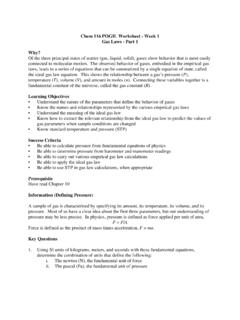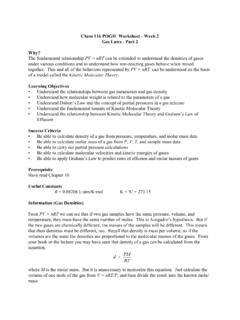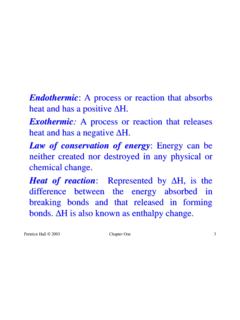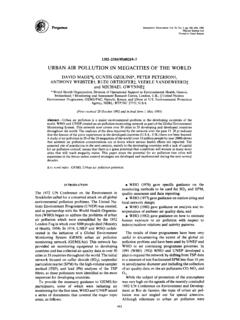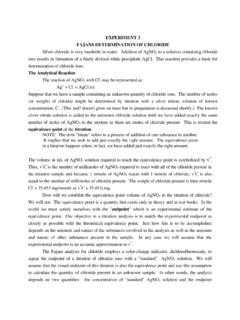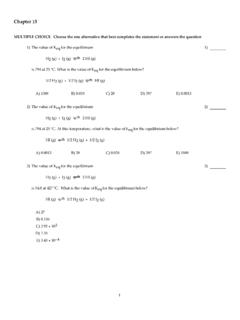Transcription of Chapter 11 Intermolecular Forces, Liquids, and Solids
1 IntermolecularForcesChapter 11 Intermolecular Forces, Liquids, and SolidsChemistry, The Central Science, 10th editionTheodore L. Brown; H. Eugene LeMay, Jr.; and Bruce E. BurstenIntermolecularForcesStates of MatterThe fundamental difference between states of matter is the distance between of MatterBecause in the solid and liquid states particles are closer together, we refer to them as condensed States of Matter The state a substance is in at a particular temperature and pressure depends on two antagonistic entities: The kinetic energy of the particles The strength of the attractions between the particlesIntermolecularForcesIntermolecu larForcesIntermolecular ForcesThe attractions between molecules are not nearly as strong as the intramolecular attractions that hold compounds ForcesThey are, however, strong enough to control physical properties such as boiling and melting points , vapor pressures, and ForcesThese Intermolecular forces as a group are referred to as van der Waals der Waals Forces Dipole-dipole interactions Hydrogen bonding London dispersion forcesIntermolecularForcesIon-Dipole Interactions A fourth type of force, ion-dipole interactions are an important force in solutions of ions.
2 The strength of these forces are what make it possible for ionic substances to dissolve in polar Interactions Molecules that have permanent dipoles are attracted to each other. The positive end of one is attracted to the negative end of the other and vice-versa. These forces are only important when the molecules are close to each InteractionsThe more polar the molecule, the higher is its boiling Dispersion ForcesWhile the electrons in the 1sorbital of helium would repel each other (and, therefore, tend to stay far away from each other), it does happen that they occasionally wind up on the same side of the Dispersion ForcesAt that instant, then, the helium atom is polar, with an excess of electrons on the left side and a shortage on the right Dispersion ForcesAnother helium nearby, then, would have a dipole induced in it, as the electrons on the left side of helium atom 2 repel the electrons in the cloud on helium atom Dispersion ForcesLondon dispersion forces, or dispersion forces, are attractions between an instantaneous dipole and an induced Dispersion Forces These forces are present in allmolecules, whether they are polar or nonpolar.
3 The tendency of an electron cloud to distort in this way is called polarizability (to give physical polarityto).IntermolecularForcesFactors Affecting London Forces The shape of the molecule affects the strength of dispersion forces: long, skinny molecules (like n-pentane tend to have stronger dispersion forces than short, fat ones (like neopentane). This is due to the increased surface area in n-pentane that allows the molecules to make contact over the entire surface Affecting London Forces The strength of dispersion forces tends to increase with increased molecular weight. Larger atoms have larger electron clouds, which are easier to London attractionsn-pentane, -130 Cn-nonane, -54 151 CIntermolecularForcesExplaining macroscopic behavior by reasoning about Intermolecular forcesnameformulamelting pointlauric acidC11H23 COOH44 Cmyristic acidC13H27 COOH58 Cpalmitic acidC15H31 COOH63 Cstearic acidC17H35 COOH70 C IntermolecularForces As the number of carbons increases in a series of fatty the melting point increases.)
4 This is as the number of carbons increases, the chains get longer. When the chains are longer, the molecules are bigger. The larger the molecule, the greater the dispersion forces. When the attractive forces holding particles together is greater, you have to get to a higher temperature to break those forces, so the melting point is Have a Greater Effect:Dipole-Dipole Interactions or Dispersion Forces? If two molecules are of comparable size and shape, dipole-dipole interactions will likely be the dominating force. If one molecule is much larger than another, dispersion forces will likely determine its physical Do We Explain This?IntermolecularForces Water has a high boiling point, high specific heat and high heat of vaporization indicating that Intermolecular forces between the water molecules are quite strong.
5 HF and NH3 also behave the same wayIntermolecularForcesHydrogen Bonding The dipole-dipole interactions experienced when H is bonded to N, O, or F are unusually strong. We call these interactions hydrogen Hydrogen bonding is a special type of molecular attraction between the hydrogen atom in a polar bond and nonbonding electron pair on a nearby small electronegative ion or atom (usually F, O or N).IntermolecularForcesHydrogen BondingHydrogen bonding arises in part from the high electronegativity of nitrogen, oxygen, and , when hydrogen is bonded to one of those very electronegative elements, the hydrogen nucleus is which of the following substances is hydrogen bonding likely to play an important role in determining physical properties: methane (CH4), hydrazine (H2 NNH2), methyl fluoride (CH3F), or hydrogen sulfide (H2S)?
6 In which of the following substances is significant hydrogen bonding possible: methylene chloride (CH2Cl2) phosphine (PH3) hydrogen peroxide (HOOH), or acetone (CH3 COCH3)?Page 444 IntermolecularForcesSummarizing Intermolecular ForcesIntermolecularForcesSummarizingFro m weakest to strongestIncreasingstrength of attractions+1-1 LondonforcesDipole-dipoleforcesHydrogenb ondingIon-ionforcesIntermolecularForcesC omplications Any molecules that experience one type of attraction, also experience all the weaker types of attractions HCl molecules experience: Hydrogen bonding (which is the strongest form of dipole-dipole interactions), and London dispersion forcesIntermolecularForces List the substances BaCl2, H2, CO, HF, and Ne in order of increasing boiling points . The attractive forces are stronger for ionic substances than formolecular ones The Intermolecular forces of the remaining substances depend on molecular weight, polarity, and hydrogen bonding.
7 The molecular weights are H2(2), CO (28), HF (20), and Ne (20). The boiling point of H2should be the lowest because it is nonpolar and has the lowest molecular weight. The molecular weights of CO, HF, and Ne are roughly the same. Because HF can hydrogen bond, however, it should have the highest boiling point of the three. Next is CO, which is slightly polar and has the highest molecular weight. Finally, Ne, which is nonpolar, should have the lowest boiling point of these three. The predicted order of boiling points is therefore:IntermolecularForces(A)Identif y the Intermolecular forces present in the following substances, and (B) select the substance with the highest boiling point: CH3CH3, CH3OH, and CH3CH2 OHAnswers:(a)CH3CH3has only dispersion forces, whereas the other two substances have both dispersion forces and hydrogen bonds; (b)CH3CH2 OHIntermolecularForcesIntermolecular Forces Affect Many Physical PropertiesThe strength of the attractions between particles can greatly affect the properties of a substance or Resistance of a liquid to flow is called viscosity.
8 It is related to the ease with which molecules can move past each other. Viscosity increases with stronger Intermolecular forces caused by increase in the molecular weight, and decreases with higher macroscopic behavior: viscosity Viscosity is the resistance to flow in liquids Viscosity is dependent on more than just molecule size it also depends on the kinds of attractive forces between molecules Viscosities of various liquids at 20 C (in centipoise)LiquidViscosity (cp)Type of IM & Londontetrachloromethane (CCl4) oil84 Londonoleic acid25 Londonglycerine1490H-bonding & LondonIntermolecularForcesSurface TensionSurface tension results from the net inward force experienced by the molecules on the surface of a ChangesIntermolecularForcesEnergy Changes Associated with Changes of State Heat of Fusion.
9 Energy required to change a solid at its melting point to a Changes Associated with Changes of State Heat of Vaporization:Energy required to change a liquid at its boiling point to a Heat of Sublimation: Is the enthalpy change required to transform a solid directly into gaseous state. IntermolecularForces A refrigerator contains an enclosed gas that can be liquefied under pressure. The liquid absorbs heat as it subsequently evaporates and the refrigerator cools in the process. The vapor is then recycled through a compressor. The heat absorbed by the liquid during vaporization is released during condensation. This heat is dissipated through cooling coils at the back of the unit. IntermolecularForcesEnergy Changes Associated with Changes of State The heat added to the system at the melting and boiling points goes into pulling the molecules farther apart from each other.
10 The temperature of the substance does not rise during the phase Calculate the enthalpy change upon converting mol of ice at 25 C to water vapor (steam) at 125 C under a constant pressure of 1 atm. The specific heats of ice, water, and steam are J/g-K, J/g-K and J/g-K, respectively. For H2O, Hfus= kJ/mol and Hvap= kJ/mol. H = mc T At the phase change H = m x enthalpy of fusion or vaporizationIntermolecularForces What is the enthalpy change during the process in which g of water at C is cooled to ice at C? The specific heats of ice, water, and steam are J/g-K, J/g-K and J/g-K, respectively. For H2O, Hfus= kJ/mol and Hvap= print another copy of the lab Temperature and Pressure The highest temperature at which a distinct liquid phase can form is called the critical temperature.


